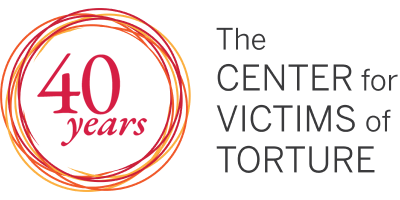What is torture?
Torture is the intentional infliction of physical or psychological pain and suffering by or at the behest or acquiescence of any member or official of the state in power. This abhorrent practice represents a deliberate and systematic dismantling of a person’s identity and humanity through physical or psychological pain and suffering. The most common forms of torture reported by CVT clients are beatings and psychological torture. It is estimated there are over 50,000 torture survivors in Minnesota and as many as 1.3 million in the U.S. The United Nations’ definition of torture is contained in the Convention against Torture and Other Cruel, Inhuman or Degrading Treatment or Punishment.
What are the effects of torture?
Torture can lead to multiple disabling conditions that interfere with even the most basic functions of daily life. Symptoms can include chronic pain in muscles and joints, headaches, incessant nightmares and other sleep disorders, stomach pain and nausea, severe depression and anxiety, guilt, self-hatred, inability to concentrate, post-traumatic stress disorder and thoughts of suicide. Survivors of torture and war atrocities can become immobilized by their feelings and symptoms, unable to function within their communities or contribute to their family’s well-being.
Why is torture wrong?
Torture affects five basic human needs: the need to feel safe, the need to trust, the need to feel of value (self-worth), the need to feel close to others, and the need to feel some control over one’s life. Torture’s purpose is to break an individual’s will and render them helpless, destroy a sense of community, stifle civil society, create a climate of fear and silence dissent.
What does CVT do?
CVT works in several interrelated areas – providing clinical care to torture and trauma survivors; building capacity, skills and resilience of human rights defenders and organizations which support survivors; and public policy and human rights advocacy. In addition, CVT conducts research on and evaluation of rehabilitative care for survivors to determine the effects of torture and successful treatment approaches.
How do survivors hear about CVT?
Many survivors hear about CVT through outreach and psychoeducation sessions within the communities where survivors live. Many individuals also find CVT through word of mouth in the community and referrals by health care, legal and community services organizations.
What are CVT’s public policy priorities?
CVT’s federal policy advocacy centers on appropriations to government programs that fund torture survivor rehabilitation in the U.S. and internationally and national security and human rights issues. In all of our policy advocacy work, we leverage the credibility gained through extending care and rehabilitation to torture survivors into effective campaigns that generate broad and bipartisan political support.
How is CVT funded?
The Fiscal Year 2025 budget totals $36 million, of which $6 million will be contributed by individuals, foundations, corporate philanthropies and other institutions. $30 million will be earned through government contracts and medical and case management billing.
What is the New Tactics in Human Rights program?
Through the New Tactics in Human Rights program, CVT promotes tactical innovation and strategic thinking within the international human rights community on various human rights issues. Through a vast network of workshops, publications and online discussions, local activists can share strategies and tactics that have worked elsewhere and apply them to new regions or issues.
